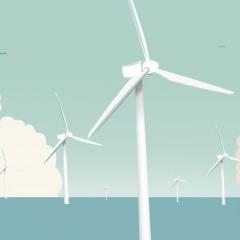[The following article supported a panel discussion as part of the event "Conversation Series: The Future of Sutainability Solutions", co-hosted by CPF and the Australian Institute for Business and Econnomics at Customs House on June 3, 2021. Click here to view a recording of the event.]
What do we need to implement sustainable transport options?
Emissions from transport contribute 25% of carbon dioxide emissions from fuel combustion. This proportion varies across different nations but of the larger emitters, the country with the highest contribution to total emissions is the USA at 36% and the country with the lowest is China at 10%. Sustainable transport options include greater utilisation of public transport, but we all know that public transport is less flexible and convenient. We can also consider greater use of novel modes like scooters and segways, but their application is niche and unlikely to replace motor vehicles. Therefore, led by China and Europe, sustainable transport solutions are already focused on electrification, in particular electric vehicles.
Sustainable transport policy measures in China started in 1995 with the identification of transport electrification as a National Key Science and Technology Industrialisation Project. Successive Five Year Plans increased support for domestically manufactured electric vehicles which has resulted in annual sales of EVs in China increasing from 1500 in 2010 to 931000 in 2019. China also has 502000 electric buses, 97% of the world’s stock of electric buses. China’s pursuit of sustainable transport options in 1995 came before more recent city air quality measures, and its success is embedded in the Chinese perception that the development of an electric vehicle industry was a way to compete against more advanced internal combustion engine vehicle manufacturers and thus carve out economic development from the emergence of a new market.
Europe’s shift into vehicle electrification has been slower because of its existing ICE auto manufacturing industry. Tailpipe emission standards have attempted to encourage increased energy efficiency as well as emission reduction. However, it has only been since 2019, that the standards have been set so low (3.5l/100km by 2025, and 3l/100km by 2030) that the automakers are now compelled to introduce significant numbers of EV models into their fleet sales. Coupled with the competition that has sprung up from China’s EVs and the US’s Teslas, the European automakers have committed to heavy investment in new EV models, vehicle manufacture and Li-ion battery manufacturing.
We can of course point to the argument that shifting the energy source from oil to electricity will not necessarily reduce emissions if electricity is generated from fossil fuels. But, the reducing cost of renewable energy generation, and Europe’s ambitious emission reduction targets, is also reducing emissions from electricity generation. Renewable energy now comprises 34% of electricity supply in Europe, 45% in the industrial heartland of Germany. Germany’s existing renewable energy target for 2030 is 65%, but there are calls to increase the target to 75-80% to accommodate the electrification of transport. So European transport electrification can produce sustainable transport outcomes.
The EU Green Deal is an industrial policy framework, announced in 2019, aimed at economic development from the shift to sustainability through decarbonisation. The Green Deal Investment Plan (GDIP) will mobilise nearly € 1 trillion from 2020-30 to finance projects that will tackle climate change and economic development. The EC recognises that the transition to sustainable growth requires more than public funding. It is therefore seeking to reorient private capital by classifying projects according to their environmental, societal and governance (ESG) credentials based on an agreed taxonomy and effectively creating an EU Ecolabel for investment and financial products.
These measures create an enabling framework for private investors and public administrations to facilitate sustainable investment. They are already influencing investment decisions taken by car makers, steering them towards zero emission vehicles earlier than originally planned, influencing green investment banks to support investments considered more sustainable, and financing li-ion Giga-factories.
What needs to happen to facilitate this shift to transport sustainability?
The International Energy Agency predicts that Europe and China’s current policy measures will drive global annual sales of EVs to increase from 3 million last year to 13 million in 2025 and 26 million in 2030. That equates to a 33% annual increase in EV sales over the next 4 years. The li-ion battery for each vehicle, depending on the battery chemistry, requires upwards of 50-60 kgs of copper, 50 kgs of nickel, 70 kgs of graphite, 10 kgs of cobalt, and 10 kgs of lithium. The IEA has found that the metals required to supply to this level of EV sales, as well as the very large increase in renewable energy, is hopelessly inadequate. Just to meet demand in 2030 projected from existing policy settings, supply of these critical minerals has to increase by around 20% per annum. Long lead times to get mining projects underway, declining ore grades from existing mines, ESG concerns associated with mining and water stress create substantial and real risks to supply and the transition to more sustainable transportation. The IEA has called for government commitment to geological surveys to validate deposits, research into novel mining and chemical refining processes, and strong signals that facilitate investment decisions to speed up project delivery to create supply chain resilience.
Queensland, and Australia, are perfectly situated to contribute to global supply chain resilience by increasing investment in critical minerals, rolling out world class research from our laboratories, building a minerals processing and manufacturing sector, to support regional centres.
What’s stopping us? A lack of policy settings! We need a vision, or strategy, to establish Queensland as a supply chain partner to Europe, and an industrial policy framework to support the green-tech start-ups that will supply mined ore, processed battery precursor materials, electro-chemicals and lithium cells to the 22 Giga-factories under-construction or in plan for Europe by 2023.



